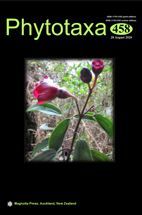Abstract
This is the second in a series of papers in which we examine the type species of genera in Parmulariaceae. Specimens of type species of Hysterostomella, Mintera, Rhipidocarpon and Viegasella are re-examined and their descriptions and illustrations are provided. Hysterostomella is characterized by large, black, circular or elliptical ascostromata, later becoming irregular, rather flat and opening by irregular fissures. Asci are subglobose, obovoid and bitunicate and ascospores are dark brown, ellipsoidal with a single septum. Mintera is similar to Viegasella in having radiating, loculate ascostromata forming on leaf surfaces. However, Mintera is distinguished by its appressoriate mycelium. Rhipidocarpon has carbonaceous, flattened ascostromata with ridges, irregularly radiating from centre to the outer rim, becoming a fan-shape, ridges containing elongated locules, which open by a longitudinal slit and contain numerous asci. Based on their morphological characters, the placement of the genera in Parmulariaceae is confirmed.

